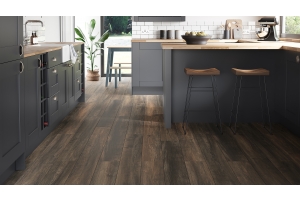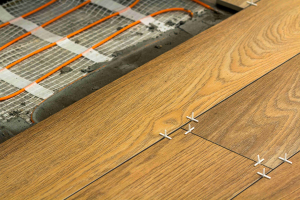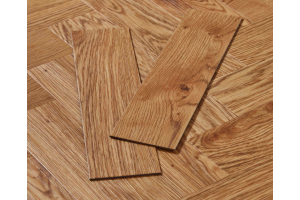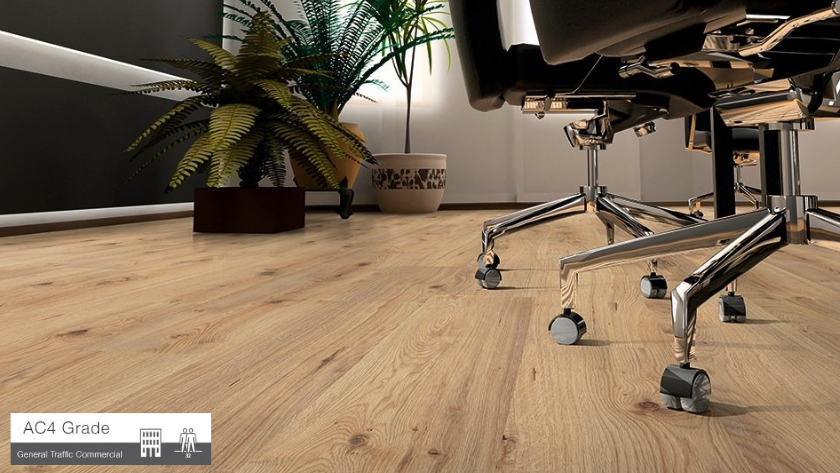
When shopping for laminate flooring, you may encounter a term referred to as a "laminate AC rating". Meaning "abrasion class", AC rating describes a floor's durability against a number of key factors. The higher the AC rating, the more durable it is. Whilst laminate with a rating of AC1 is only suitable for areas with little footfall, the higher AC5-rated laminate floors are robust enough for use in commercial buildings, such as busy retail stores.
Laminate AC rating determines how well a laminate floor copes within different environments. Abrasion class was first introduced by the Association of European Producers of Laminate Flooring (ELPF). Since its conception, it's been adopted as the industry standard for rating laminate flooring.
How is AC Rating Determined?
In order to receive an AC rating, laminate flooring must go through rigorous testing. Known as the Taber test, the process assesses the flooring to measure its resistance. The AC rating is dependent on how it deals with a number of different stress points. Abrasion, stains, impact, moisture, heat and scratches are all factors used to produce a laminate AC rating.
To receive an AC rating, every aspect of the test requires a pass. If it fails even one, it receives an "unrated" label, meaning it misses the mark in terms of quality expected by both retailers and consumers.

Two main groups divide laminate AC ratings: residential and commercial. These two groups are then split again to describe the level of traffic they're able to withstand: moderate, general or heavy.
Laminate flooring thickness often has a part to play in a difference of AC rating. Generally speaking, the higher the thickness, the better the abrasion class rating.
See also: How to maintain laminate flooring
Different Laminate AC Ratings
As we touched upon earlier, the abrasion class rating of laminate flooring depends on its ability to withstand a number of different tests. How it copes with these tests determines its rating.
So what are the different AC ratings? You'll often find them described by a simple label:
Residential
AC1
Suitable for moderate traffic. Best suited to use in bedrooms or guest rooms that see very little foot traffic.
AC2
Suitable for general traffic. Dining or living rooms are the best place for AC2-rated laminate floors.
AC3
Suitable for heavy traffic. Generally suitable for all areas, especially areas such as hallways which see a lot of footfall.
Commercial
AC4
Suitable for moderate traffic in commercial spaces. Think small offices, cafés or smaller retail outlets.
AC5
Suitable for heavy traffic in commercial spaces. Large department stores, public building and large offices are the perfect place for laminate with a rating of AC5.
You may also find AC rating described using pictograms. In these images, the different AC ratings display either a house (residential) or a commercial building (commercial). They may also contain icons for people, as well as numbers to display the laminate flooring's suitability for either moderate (1), general (2) or heavy (3) use.
![]()
Weighing Up Your Options
The higher the the laminate AC rating, the better its durability. So, that must mean you should always go for the higher rating, surely? Well, not always.
As with any flooring, making your decision depends on individual circumstances. AC1-AC4 rated laminate is made using direct pressure laminate, whilst AC5 and higher is created using high pressure laminate. The difference in their manufacturing makes for slight differences in their appearance and feel.
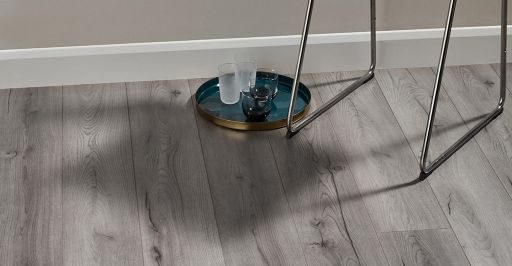 Loft Dark Grey - AC3
Loft Dark Grey - AC3Commercial spaces with heavy footfall require a high-durability laminate floor, although there are benefits to choosing lower-rated laminates as well.
AC3/AC4-rated floors tend to be smoother and softer to the touch than those with a higher rating. Whilst the rough texture of AC5 may be good for commercial use, this may be too abrasive for family homes - especially if you have young children.
Direct pressure laminate (AC1-AC4) is also better equipped to look more realistic than high pressure laminate. This is also due to the laminate flooring thickness and its wear layer. Each AC rating increase means a 60% increase in wear. So, for example, AC3 has 120% heavier wear than AC1. The heavier wear may also mean a cloudier look to your flooring. Therefore, if you prioritise style over durability, you're better suited to a lower grade flooring.
Our AC Ratings
Here at Direct Wood Flooring, we only sell laminate flooring with an AC rating of AC3 and above. This ensures high durability, without compromising on the authentic look of the flooring. Images are crisp and clear, whilst a textured surface gives an authentic real wood feel.
To find your chosen laminate's AC rating, simply scroll down the product page until you reach the AC rating in the product information.

To Conclude
Laminate AC rating is certified through rigorous testing to even receive a rating. Even with the lower AC1-AC2 floors, you can still make a decision knowing the product is certified for its purpose.
The lower AC-rated laminate flooring is better suited to residential properties, whereas higher rating such as AC4 and AC5 are perfect for commercial environments. AC3 sits in the middle, and will handle any area in your home, as well as being suitable for light commercial use.
If you're looking for laminate flooring and would like advice on the best AC rating for you, get in touch by calling 03308 088777, or email [email protected].








